Seperti rilis sebelumnya, Android 15 menyertakan perubahan perilaku yang dapat memengaruhi aplikasi Anda. Perubahan perilaku berikut ini berlaku khusus bagi aplikasi yang menargetkan Android 15 atau yang lebih tinggi. Jika aplikasi menargetkan Android 15 atau yang lebih tinggi, Anda harus memodifikasi aplikasi agar mendukung perilaku ini dengan benar, jika memungkinkan.
Selain itu, pastikan Anda meninjau daftar perubahan perilaku yang memengaruhi semua aplikasi
yang berjalan di Android 15, terlepas dari targetSdkVersion aplikasi Anda.
Fungsi inti
Android 15 memodifikasi atau memperluas berbagai kemampuan inti sistem Android.
Perubahan pada layanan latar depan
We are making the following changes to foreground services with Android 15.
- New media processing foreground service type
- Restrictions on
BOOT_COMPLETEDbroadcast receivers launching foreground services
Data sync foreground service timeout behavior
Android 15 memperkenalkan perilaku waktu tunggu baru ke dataSync untuk penargetan aplikasi
Android 15 atau yang lebih baru. Perilaku ini juga berlaku untuk mediaProcessing versi baru
jenis layanan latar depan.
Sistem mengizinkan layanan dataSync aplikasi untuk berjalan selama total 6 jam
dalam periode 24 jam, setelah itu sistem akan memanggil metode
Metode Service.onTimeout(int, int) (diperkenalkan di Android
15.) Pada saat ini, layanan memiliki waktu beberapa detik untuk memanggil
Service.stopSelf(). Saat Service.onTimeout() dipanggil,
tidak lagi dianggap sebagai layanan latar depan. Jika layanan tidak
memanggil Service.stopSelf(), sistem akan menampilkan pengecualian internal. Tujuan
dicatat di Logcat dengan pesan berikut:
Fatal Exception: android.app.RemoteServiceException: "A foreground service of
type dataSync did not stop within its timeout: [component name]"
Untuk menghindari masalah dengan perubahan perilaku ini, Anda dapat melakukan satu atau beberapa berikut ini:
- Minta layanan Anda untuk mengimplementasikan metode
Service.onTimeout(int, int)baru. Saat aplikasi menerima callback, pastikan untuk memanggilstopSelf()dalam beberapa detik. (Jika Anda tidak langsung menghentikan aplikasi, sistem akan membuat gagal.) - Pastikan layanan
dataSyncaplikasi Anda tidak berjalan selama total lebih dari 6 jam dalam periode 24 jam (kecuali jika pengguna berinteraksi dengan aplikasi, mereset timer). - Hanya memulai layanan latar depan
dataSyncsebagai hasil dari pengguna langsung interaksi; karena aplikasi Anda berada di latar depan saat layanan dimulai, layanan Anda memiliki waktu 6 jam penuh setelah aplikasi berpindah ke latar belakang. - Gunakan layanan latar depan
dataSync, bukan API alternatif.
Jika layanan latar depan dataSync aplikasi Anda telah berjalan selama 6 jam terakhir
24, Anda tidak dapat memulai layanan latar depan dataSync yang lain kecuali jika pengguna
telah membawa aplikasi Anda ke latar depan (yang akan menyetel ulang timer). Jika Anda mencoba
memulai layanan latar depan dataSync lain, sistem akan menampilkan
ForegroundServiceStartNotAllowedException
dengan pesan error seperti "Batas waktu sudah habis untuk layanan latar depan
"dataSync".
Pengujian
Untuk menguji perilaku aplikasi, Anda dapat mengaktifkan waktu tunggu sinkronisasi data meskipun aplikasi
tidak menargetkan Android 15 (selama aplikasi berjalan di Android 15
perangkat). Untuk mengaktifkan waktu tunggu, jalankan perintah adb berikut:
adb shell am compat enable FGS_INTRODUCE_TIME_LIMITS your-package-name
Anda juga dapat menyesuaikan periode waktu tunggu, untuk mempermudah menguji bagaimana
akan berperilaku saat batas tercapai. Untuk menetapkan periode waktu tunggu yang baru, jalankan
perintah adb berikut:
adb shell device_config put activity_manager data_sync_fgs_timeout_duration duration-in-milliseconds
New media processing foreground service type
Android 15 introduces a new foreground service type, mediaProcessing. This
service type is appropriate for operations like transcoding media files. For
example, a media app might download an audio file and need to convert it to a
different format before playing it. You can use a mediaProcessing foreground
service to make sure the conversion continues even while the app is in the
background.
The system permits an app's mediaProcessing services to run for a total of 6
hours in a 24-hour period, after which the system calls the running service's
Service.onTimeout(int, int) method (introduced in Android
15). At this time, the service has a few seconds to call
Service.stopSelf(). If the service does not
call Service.stopSelf(), the system throws an internal exception. The
exception is logged in Logcat with the following message:
Fatal Exception: android.app.RemoteServiceException: "A foreground service of
type mediaProcessing did not stop within its timeout: [component name]"
To avoid having the exception, you can do one of the following:
- Have your service implement the new
Service.onTimeout(int, int)method. When your app receives the callback, make sure to callstopSelf()within a few seconds. (If you don't stop the app right away, the system generates a failure.) - Make sure your app's
mediaProcessingservices don't run for more than a total of 6 hours in any 24-hour period (unless the user interacts with the app, resetting the timer). - Only start
mediaProcessingforeground services as a result of direct user interaction; since your app is in the foreground when the service starts, your service has the full six hours after the app goes to the background. - Instead of using a
mediaProcessingforeground service, use an alternative API, like WorkManager.
If your app's mediaProcessing foreground services have run for 6 hours in the
last 24, you cannot start another mediaProcessing foreground service unless
the user has brought your app to the foreground (which resets the timer). If you
try to start another mediaProcessing foreground service, the system throws
ForegroundServiceStartNotAllowedException
with an error message like "Time limit already exhausted for foreground service
type mediaProcessing".
For more information about the mediaProcessing service type, see Changes to
foreground service types for Android 15: Media processing.
Testing
To test your app's behavior, you can enable media processing timeouts even if
your app is not targeting Android 15 (as long as the app is running on an
Android 15 device). To enable timeouts, run the following adb command:
adb shell am compat enable FGS_INTRODUCE_TIME_LIMITS your-package-name
You can also adjust the timeout period, to make it easier to test how your
app behaves when the limit is reached. To set a new timeout period, run the
following adb command:
adb shell device_config put activity_manager media_processing_fgs_timeout_duration duration-in-milliseconds
Restrictions on BOOT_COMPLETED broadcast receivers launching foreground services
There are new restrictions on BOOT_COMPLETED broadcast receivers launching
foreground services. BOOT_COMPLETED receivers are not allowed to launch the
following types of foreground services:
dataSynccameramediaPlaybackphoneCallmediaProjectionmicrophone(this restriction has been in place formicrophonesince Android 14)
If a BOOT_COMPLETED receiver tries to launch any of those types of foreground
services, the system throws ForegroundServiceStartNotAllowedException.
Testing
To test your app's behavior, you can enable these new restrictions even if your
app is not targeting Android 15 (as long as the app is running on an Android 15
device). Run the following adb command:
adb shell am compat enable FGS_BOOT_COMPLETED_RESTRICTIONS your-package-name
To send a BOOT_COMPLETED broadcast without restarting the device,
run the following adb command:
adb shell am broadcast -a android.intent.action.BOOT_COMPLETED your-package-name
Restrictions on starting foreground services while an app holds the SYSTEM_ALERT_WINDOW permission
Previously, if an app held the SYSTEM_ALERT_WINDOW permission, it could launch
a foreground service even if the app was currently in the background (as
discussed in exemptions from background start restrictions).
If an app targets Android 15, this exemption is now narrower. The app now needs
to have the SYSTEM_ALERT_WINDOW permission and also have a visible overlay
window. That is, the app needs to first launch a
TYPE_APPLICATION_OVERLAY window and the window
needs to be visible before you start a foreground service.
If your app attempts to start a foreground service from the background without
meeting these new requirements (and it does not have some other exemption), the
system throws ForegroundServiceStartNotAllowedException.
If your app declares the SYSTEM_ALERT_WINDOW permission
and launches foreground services from the background, it may be affected by this
change. If your app gets a ForegroundServiceStartNotAllowedException, check
your app's order of operations and make sure your app already has an active
overlay window before it attempts to start a foreground service from the
background. You can check if your overlay window is currently visible
by calling View.getWindowVisibility(), or you
can override View.onWindowVisibilityChanged()
to get notified whenever the visibility changes.
Testing
To test your app's behavior, you can enable these new restrictions even if your
app is not targeting Android 15 (as long as the app is running on an Android 15
device). To enable these new restrictions on starting foreground services
from the background, run the following adb command:
adb shell am compat enable FGS_SAW_RESTRICTIONS your-package-name
Perubahan terkait waktu aplikasi dapat mengubah status global mode Jangan Ganggu
Apps that target Android 15 can no longer change the global state or policy of
Do Not Disturb (DND) on a device (either by modifying user settings, or turning
off DND mode). Instead, apps must contribute an AutomaticZenRule, which
the system combines into a global policy with the existing
most-restrictive-policy-wins scheme. Calls to existing APIs that previously
affected global state (setInterruptionFilter,
setNotificationPolicy) result in the creation or update of an
implicit AutomaticZenRule, which is toggled on and off depending on the
call-cycle of those API calls.
Note that this change only affects observable behavior if the app is calling
setInterruptionFilter(INTERRUPTION_FILTER_ALL) and expects that call to
deactivate an AutomaticZenRule that was previously activated by their owners.
Perubahan OpenJDK API
Android 15 melanjutkan pekerjaan memuat ulang library inti Android untuk menyelaraskan dengan fitur dalam rilis terbaru OpenJDK LTS.
Beberapa perubahan ini dapat memengaruhi kompatibilitas aplikasi untuk penargetan aplikasi Android 15 (level API 35):
Perubahan pada API pemformatan string: Validasi indeks argumen, flag, lebar, dan presisi sekarang lebih ketat saat menggunakan API
String.format()danFormatter.format():String.format(String, Object[])String.format(Locale, String, Object[])Formatter.format(String, Object[])Formatter.format(Locale, String, Object[])
Misalnya, pengecualian berikut ditampilkan saat indeks argumen 0 digunakan (
%0dalam string format):IllegalFormatArgumentIndexException: Illegal format argument index = 0Dalam kasus ini, masalah dapat diperbaiki menggunakan indeks argumen 1 (
%1di string format).Perubahan pada jenis komponen
Arrays.asList(...).toArray(): Saat menggunakanArrays.asList(...).toArray(), jenis komponen array yang dihasilkan adalah sekarangObject—bukan jenis elemen array yang mendasarinya. Jadi, kode berikut akan menampilkanClassCastException:String[] elements = (String[]) Arrays.asList("one", "two").toArray();Untuk hal ini, pertahankan
Stringsebagai jenis komponen dalam hasil Anda dapat menggunakanCollection.toArray(Object[])sebagai gantinya:String[] elements = Arrays.asList("two", "one").toArray(new String[0]);Perubahan pada penanganan kode bahasa: Saat menggunakan
LocaleAPI, kode bahasa untuk bahasa Ibrani, Yiddi, dan Indonesia tidak lagi dikonversi ke bentuk yang sudah tidak berlaku (Ibrani:iw, Yiddi:ji, dan bahasa Indonesia:in). Ketika menetapkan kode bahasa untuk salah satu lokal ini, gunakan kode tersebut dari ISO 639-1 (Ibrani:he, Yiddi:yi, dan Bahasa Indonesia:id).Perubahan pada urutan int acak: Mengikuti perubahan yang dibuat di https://bugs.openjdk.org/browse/JDK-8301574, berikut Metode
Random.ints()sekarang menampilkan urutan angka yang berbeda dari metodeRandom.nextInt()melakukan:Umumnya, perubahan ini seharusnya tidak menyebabkan perilaku yang merusak aplikasi, tetapi kode seharusnya tidak mengharapkan urutan yang dihasilkan dari metode
Random.ints()cocok denganRandom.nextInt().
SequencedCollection API baru dapat memengaruhi kompatibilitas aplikasi Anda
setelah Anda mengupdate compileSdk dalam konfigurasi build aplikasi Anda untuk menggunakan
Android 15 (level API 35):
Bertumbukan dengan
MutableList.removeFirst()dan Fungsi ekstensiMutableList.removeLast()dikotlin-stdlibJenis
Listdi Java dipetakan ke jenisMutableListdi Kotlin. Karena APIList.removeFirst()danList.removeLast()diperkenalkan di Android 15 (API level 35), compiler Kotlin me-resolve panggilan fungsi, misalnyalist.removeFirst(), secara statis keListAPI baru, bukan fungsi ekstensi dikotlin-stdlib.Jika aplikasi dikompilasi ulang dengan
compileSdkdisetel ke35danminSdkdisetel ke34atau lebih rendah, lalu aplikasi berjalan di Android 14 dan yang lebih rendah, runtime ditampilkan kesalahan:java.lang.NoSuchMethodError: No virtual method removeFirst()Ljava/lang/Object; in class Ljava/util/ArrayList;Opsi lint
NewApiyang ada di Plugin Android Gradle dapat menangkap penggunaan API baru../gradlew lintMainActivity.kt:41: Error: Call requires API level 35 (current min is 34): java.util.List#removeFirst [NewApi] list.removeFirst()Untuk memperbaiki pengecualian runtime dan error lint,
removeFirst()dan Panggilan fungsiremoveLast()dapat diganti denganremoveAt(0)danremoveAt(list.lastIndex)masing-masing di Kotlin. Jika Anda menggunakan Kepik Android Studio | 2024.1.3 atau yang lebih tinggi, ini juga memberikan perbaikan cepat untuk pesan error ini.Sebaiknya hapus
@SuppressLint("NewApi")danlintOptions { disable 'NewApi' }jika opsi lint telah dinonaktifkan.Tabrakan dengan metode lain di Java
Metode baru telah ditambahkan ke dalam jenis yang ada, misalnya,
ListdanDeque. Metode baru ini mungkin tidak kompatibel dengan metode dengan nama dan jenis argumen yang sama di antarmuka lain dan class. Dalam kasus tabrakan tanda tangan metode dengan inkompatibilitas, compilerjavacakan menghasilkan error waktu build. Contoh:Contoh error 1:
javac MyList.javaMyList.java:135: error: removeLast() in MyList cannot implement removeLast() in List public void removeLast() { ^ return type void is not compatible with Object where E is a type-variable: E extends Object declared in interface ListContoh error 2:
javac MyList.javaMyList.java:7: error: types Deque<Object> and List<Object> are incompatible; public class MyList implements List<Object>, Deque<Object> { both define reversed(), but with unrelated return types 1 errorContoh error 3:
javac MyList.javaMyList.java:43: error: types List<E#1> and MyInterface<E#2> are incompatible; public static class MyList implements List<Object>, MyInterface<Object> { class MyList inherits unrelated defaults for getFirst() from types List and MyInterface where E#1,E#2 are type-variables: E#1 extends Object declared in interface List E#2 extends Object declared in interface MyInterface 1 errorUntuk memperbaiki error build ini, class yang mengimplementasikan antarmuka ini harus mengganti metode dengan jenis nilai yang ditampilkan yang kompatibel. Contoh:
@Override public Object getFirst() { return List.super.getLast(); }
Keamanan
Android 15 menyertakan perubahan yang mempromosikan keamanan sistem untuk membantu melindungi aplikasi dan pengguna dari aplikasi berbahaya.
Peluncuran aktivitas latar belakang yang aman
Android 15 protects users from malicious apps and gives them more control over their devices by adding changes that prevent malicious background apps from bringing other apps to the foreground, elevating their privileges, and abusing user interaction. Background activity launches have been restricted since Android 10 (API level 29).
Block apps that don't match the top UID on the stack from launching activities
Malicious apps can launch another app's activity within the same task, then
overlay themselves on top, creating the illusion of being that app. This "task
hijacking" attack bypasses current background launch restrictions because it all
occurs within the same visible task. To mitigate this risk, Android 15 adds a
flag that blocks apps that don't match the top UID on the stack from launching
activities. To opt in for all of your app's activities, update the
allowCrossUidActivitySwitchFromBelow
attribute in your app's AndroidManifest.xml file:
<application android:allowCrossUidActivitySwitchFromBelow="false" >
The new security measures are active if all of the following are true:
- The app performing the launch targets Android 15.
- The app on top of the task stack targets Android 15.
- Any visible activity has opted in to the new protections
If the security measures are enabled, apps might return home, rather than the last visible app, if they finish their own task.
Other changes
In addition to the restriction for UID matching, these other changes are also included:
- Change
PendingIntentcreators to block background activity launches by default. This helps prevent apps from accidentally creating aPendingIntentthat could be abused by malicious actors. - Don't bring an app to the foreground unless the
PendingIntentsender allows it. This change aims to prevent malicious apps from abusing the ability to start activities in the background. By default, apps are not allowed to bring the task stack to the foreground unless the creator allows background activity launch privileges or the sender has background activity launch privileges. - Control how the top activity of a task stack can finish its task. If the top activity finishes a task, Android will go back to whichever task was last active. Moreover, if a non-top activity finishes its task, Android will go back to the home screen; it won't block the finish of this non-top activity.
- Prevent launching arbitrary activities from other apps into your own task. This change prevents malicious apps from phishing users by creating activities that appear to be from other apps.
- Block non-visible windows from being considered for background activity launches. This helps prevent malicious apps from abusing background activity launches to display unwanted or malicious content to users.
Intent yang lebih aman
Android 15 introduces new security measures to make intents safer and more robust. These changes are aimed at preventing potential vulnerabilities and misuse of intents that can be exploited by malicious apps. There are two main improvements to the security of intents in Android 15:
- Match target intent-filters: Intents that target specific components must accurately match the target's intent-filter specifications. If you send an intent to launch another app's activity, the target intent component needs to align with the receiving activity's declared intent-filters.
- Intents must have actions: Intents without an action will no longer match any intent-filters. This means that intents used to start activities or services must have a clearly defined action.
- Pending intents: The creator of the pending intent is treated as the sender of the enclosing intent, not the sender of the pending intent
Kotlin
fun onCreate() {
StrictMode.setVmPolicy(VmPolicy.Builder()
.detectUnsafeIntentLaunch()
.build()
)
}
Java
public void onCreate() {
StrictMode.setVmPolicy(new VmPolicy.Builder()
.detectUnsafeIntentLaunch()
.build());
}
Pengalaman pengguna dan UI sistem
Android 15 menyertakan beberapa perubahan yang dimaksudkan untuk menciptakan pengalaman pengguna yang lebih konsisten dan intuitif.
Perubahan inset jendela
Ada dua perubahan terkait inset jendela di Android 15: tata letak layar penuh diterapkan secara default, dan ada juga perubahan konfigurasi, seperti konfigurasi default kolom sistem.
Edge-to-edge enforcement
Aplikasi ditampilkan di layar penuh secara default di perangkat yang menjalankan Android 15 jika aplikasi yang menargetkan Android 15 (level API 35).
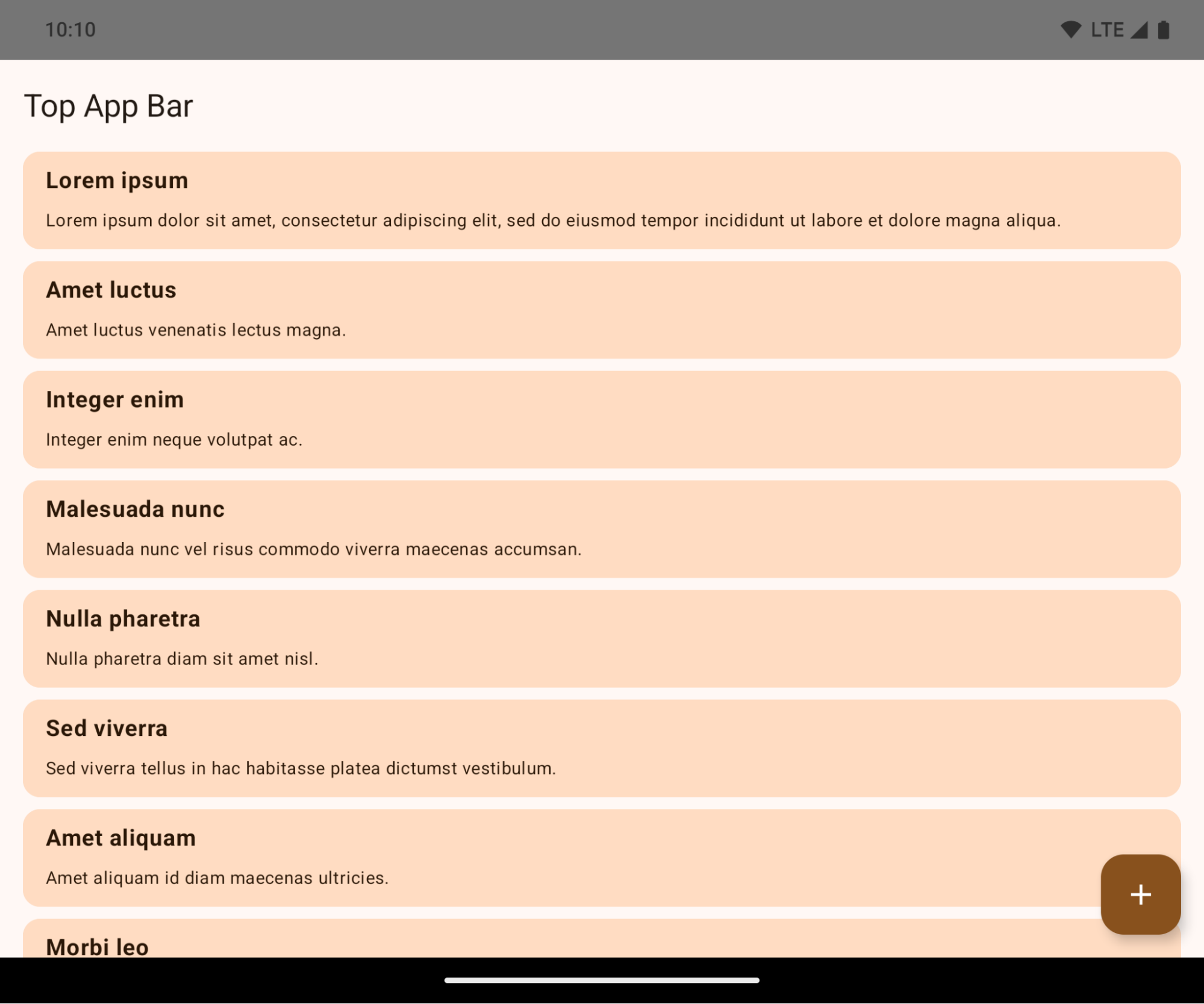
Ini adalah perubahan yang dapat menyebabkan gangguan yang mungkin berdampak negatif terhadap UI aplikasi Anda. Tujuan perubahan tersebut memengaruhi area UI berikut:
- Menu navigasi handel gestur
- Transparan secara default.
- Offset bawah dinonaktifkan sehingga konten digambar di belakang navigasi sistem kecuali jika inset diterapkan.
setNavigationBarColordanR.attr#navigationBarColoradalah tidak digunakan lagi dan tidak memengaruhi navigasi gestur.setNavigationBarContrastEnforceddanR.attr#navigationBarContrastEnforcedtetap tidak berpengaruh pada navigasi gestur.
- Navigasi 3 tombol
- Opasitas disetel ke 80% secara default, dengan warna yang mungkin sesuai dengan jendela latar belakang.
- Offset bawah dinonaktifkan sehingga konten digambar di belakang menu navigasi sistem kecuali jika inset diterapkan.
setNavigationBarColordanR.attr#navigationBarColoradalah disetel agar sesuai dengan latar belakang jendela secara {i>default<i}. Latar belakang jendela harus berupa warna yang dapat digambar agar default ini dapat diterapkan. API ini merupakan tidak digunakan lagi tetapi terus memengaruhi navigasi 3 tombol.setNavigationBarContrastEnforceddanR.attr#navigationBarContrastEnforcedbernilai benar (true) secara default, yang menambahkan Latar belakang buram 80% pada navigasi 3 tombol.
- Status bar
- Transparan secara default.
- Offset atas dinonaktifkan sehingga konten digambar di belakang status bar kecuali inset akan diterapkan.
setStatusBarColordanR.attr#statusBarColoradalah tidak digunakan lagi dan tidak berpengaruh di Android 15.setStatusBarContrastEnforceddanR.attr#statusBarContrastEnforcedtidak digunakan lagi, tetapi masih memiliki di Android 15.
- Potongan layar
layoutInDisplayCutoutModejendela yang tidak mengambang harusLAYOUT_IN_DISPLAY_CUTOUT_MODE_ALWAYS.SHORT_EDGES,NEVER, danDEFAULTditafsirkan sebagaiALWAYSsehingga pengguna tidak melihat notifikasi Hitam yang disebabkan oleh potongan layar dan tampak dari tepi ke tepi.
Contoh berikut menunjukkan aplikasi sebelum dan sesudah penargetan Android 15 (level API 35), serta sebelum dan sesudah menerapkan inset.
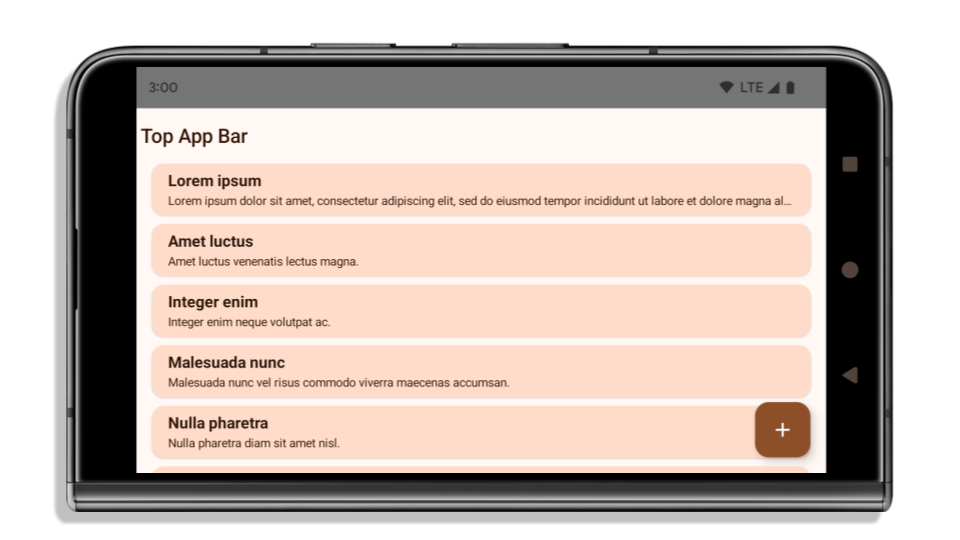
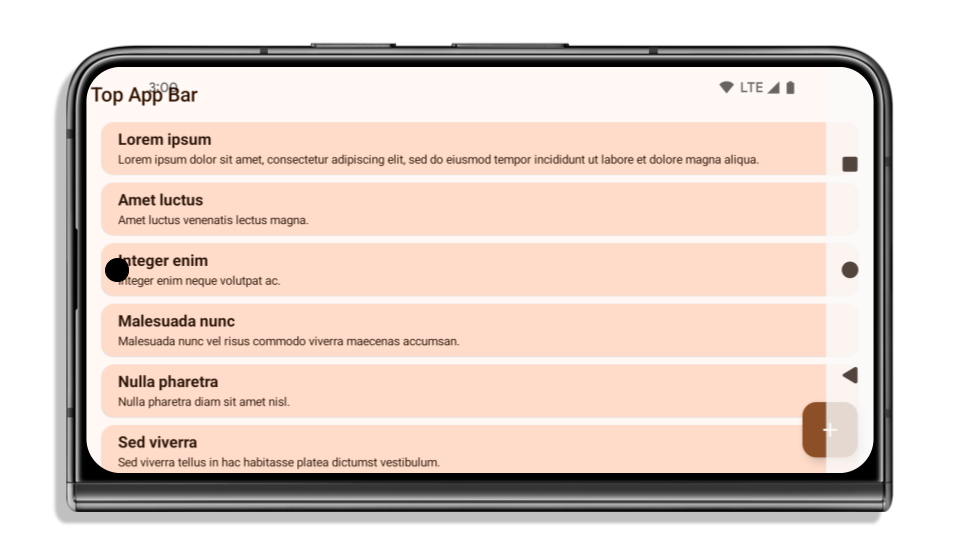

Yang harus diperiksa apakah aplikasi Anda sudah berada di layar penuh
Jika aplikasi Anda sudah merupakan edge-to-edge dan menerapkan inset, Anda sebagian besar tidak terdampak, kecuali dalam skenario berikut. Namun, bahkan jika Anda berpikir Anda tidak akan terpengaruh, sebaiknya uji aplikasi Anda.
- Anda memiliki jendela yang tidak mengambang, seperti
Activityyang menggunakanSHORT_EDGES,NEVER, atauDEFAULT, bukanLAYOUT_IN_DISPLAY_CUTOUT_MODE_ALWAYS. Jika aplikasi Anda error saat diluncurkan, mungkin karena layar pembuka Anda. Anda dapat mengupgrade inti dependensi layar pembuka ke 1.2.0-alpha01 atau yang lebih baru, atau setelwindow.attributes.layoutInDisplayCutoutMode = WindowManager.LayoutInDisplayCutoutMode.always. - Mungkin ada layar dengan traffic yang lebih rendah dengan UI yang terhalang. Verifikasi ini
layar yang jarang dikunjungi tidak memiliki UI yang tertutup. Layar dengan traffic yang lebih rendah mencakup:
- Layar orientasi atau login
- Halaman setelan
Yang harus diperiksa jika aplikasi Anda belum tata letak layar penuh
Jika aplikasi Anda belum layar penuh, kemungkinan besar Anda akan terpengaruh. Di beberapa selain skenario untuk aplikasi yang sudah {i>edge-to-edge<i}, Anda harus pertimbangkan hal berikut:
- Jika aplikasi Anda menggunakan Komponen Material 3 (
androidx.compose.material3) di compose, sepertiTopAppBar,BottomAppBar, danNavigationBar, komponen ini kemungkinan tidak terdampak karena mereka menangani inset secara otomatis. - Jika aplikasi Anda menggunakan Komponen Material 2 (
androidx.compose.material) di Compose, komponen ini tidak menangani inset secara otomatis. Namun, Anda bisa mendapatkan akses ke inset dan menerapkannya secara manual. Di androidx.compose.material 1.6.0 dan yang lebih baru, gunakan parameterwindowInsetsuntuk menerapkan inset secara manual untukBottomAppBar,TopAppBar,BottomNavigation, danNavigationRail. Demikian pula, gunakan parametercontentWindowInsetsuntukScaffold. - Jika aplikasi Anda menggunakan tampilan dan Komponen Material
(
com.google.android.material), Materi berbasis penayangan terbanyak Komponen sepertiBottomNavigationView,BottomAppBar,NavigationRailView, atauNavigationView, menangani inset dan tidak memerlukan pekerjaan tambahan. Namun, Anda perlu menambahkanandroid:fitsSystemWindows="true"jika menggunakanAppBarLayout. - Untuk composable kustom, terapkan inset secara manual sebagai padding. Jika
konten berada dalam
Scaffold, Anda dapat menggunakan inset menggunakanScaffoldnilai padding. Jika tidak, terapkan padding menggunakan salah satuWindowInsets. - Jika aplikasi Anda menggunakan tampilan dan
BottomSheet,SideSheet, atau kustom container, terapkan padding menggunakanViewCompat.setOnApplyWindowInsetsListenerSebagaiRecyclerView, terapkan padding menggunakan pemroses ini dan juga tambahkanclipToPadding="false".
Yang harus diperiksa apakah aplikasi Anda harus menawarkan perlindungan latar belakang kustom
Jika aplikasi Anda harus menawarkan perlindungan latar belakang kustom ke navigasi 3 tombol atau
status bar, aplikasi Anda harus menempatkan composable atau tampilan di belakang kolom sistem
menggunakan WindowInsets.Type#tappableElement() untuk mendapatkan tombol 3 tombol
tinggi menu navigasi, atau WindowInsets.Type#statusBars.
Resource tata letak layar penuh tambahan
Lihat Edge to Edge Views dan Edge to Edge Compose panduan untuk pertimbangan tambahan tentang penerapan inset.
API yang tidak digunakan lagi
API berikut sekarang tidak digunakan lagi:
R.attr#enforceStatusBarContrastR.attr#navigationBarColorR.attr#navigationBarDividerColorR.attr#statusBarColorWindow#getNavigationBarColorWindow#getNavigationBarDividerColorWindow#getStatusBarColorWindow#isStatusBarContrastEnforcedWindow#setDecorFitsSystemWindowsWindow#setNavigationBarColorWindow#setNavigationBarDividerColorWindow#setStatusBarColorWindow#setStatusBarContrastEnforced
Stable configuration
If your app targets Android 15 (API level 35) or higher, Configuration no
longer excludes the system bars. If you use the screen size in the
Configuration class for layout calculation, you should replace it with better
alternatives like an appropriate ViewGroup, WindowInsets, or
WindowMetricsCalculator depending on your need.
Configuration has been available since API 1. It is typically obtained from
Activity.onConfigurationChanged. It provides information like window density,
orientation, and sizes. One important characteristic about the window sizes
returned from Configuration is that it previously excluded the system bars.
The configuration size is typically used for resource selection, such as
/res/layout-h500dp, and this is still a valid use case. However, using it for
layout calculation has always been discouraged. If you do so, you should move
away from it now. You should replace the use of Configuration with something
more suitable depending on your use case.
If you use it to calculate the layout, use an appropriate ViewGroup, such as
CoordinatorLayout or ConstraintLayout. If you use it to determine the height
of the system navbar, use WindowInsets. If you want to know the current size
of your app window, use computeCurrentWindowMetrics.
The following list describes the fields affected by this change:
Configuration.screenWidthDpandscreenHeightDpsizes no longer exclude the system bars.Configuration.smallestScreenWidthDpis indirectly affected by changes toscreenWidthDpandscreenHeightDp.Configuration.orientationis indirectly affected by changes toscreenWidthDpandscreenHeightDpon close-to-square devices.Display.getSize(Point)is indirectly affected by the changes inConfiguration. This was deprecated beginning in API level 30.Display.getMetrics()has already worked like this since API level 33.
Atribut eleganTextHeight ditetapkan secara default ke benar (true)
For apps targeting Android 15, the elegantTextHeight
TextView attribute becomes true by default, replacing the
compact font used by default with some scripts that have large vertical metrics
with one that is much more readable. The compact font was introduced to prevent
breaking layouts; Android 13 (API level 33) prevents many of these breakages by
allowing the text layout to stretch the vertical height utilizing the
fallbackLineSpacing attribute.
In Android 15, the compact font still remains in the system, so your app can set
elegantTextHeight to false to get the same behavior as before, but it is
unlikely to be supported in upcoming releases. So, if your app supports the
following scripts: Arabic, Lao, Myanmar, Tamil, Gujarati, Kannada, Malayalam,
Odia, Telugu or Thai, test your app by setting elegantTextHeight to true.

elegantTextHeight behavior for apps targeting Android 14 (API level 34) and lower.
elegantTextHeight behavior for apps targeting Android 15.Perubahan lebar TextView untuk bentuk huruf yang kompleks
Pada versi Android sebelumnya, beberapa font atau bahasa tulis tangan yang memiliki
pembentukan kompleks dapat menggambar huruf di area karakter sebelumnya atau berikutnya.
Terkadang, huruf seperti itu terpotong di posisi awal atau akhir.
Mulai Android 15, TextView mengalokasikan lebar untuk menggambar ruang yang cukup
untuk huruf tersebut dan memungkinkan aplikasi meminta padding tambahan ke kiri agar
tidak terpotong.
Karena perubahan ini memengaruhi cara TextView menentukan lebar, TextView
mengalokasikan lebih banyak lebar secara default jika aplikasi menargetkan Android 15 atau yang lebih tinggi. Anda dapat mengaktifkan atau menonaktifkan perilaku ini dengan memanggil API setUseBoundsForWidth pada TextView.
Karena penambahan padding kiri dapat menyebabkan ketidaksejajaran untuk tata letak yang ada, padding tidak ditambahkan secara default bahkan untuk aplikasi yang menargetkan Android 15 atau yang lebih tinggi.
Namun, Anda dapat menambahkan padding tambahan untuk mencegah pemotongan dengan memanggil
setShiftDrawingOffsetForStartOverhang.
Contoh berikut menunjukkan bagaimana perubahan ini dapat meningkatkan tata letak teks untuk beberapa font dan bahasa.
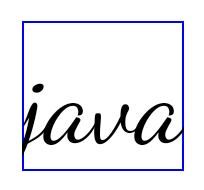
<TextView
android:fontFamily="cursive"
android:text="java" />
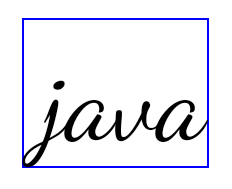
<TextView
android:fontFamily="cursive"
android:text="java"
android:useBoundsForWidth="true"
android:shiftDrawingOffsetForStartOverhang="true" />

<TextView
android:text="คอมพิวเตอร์" />

<TextView
android:text="คอมพิวเตอร์"
android:useBoundsForWidth="true"
android:shiftDrawingOffsetForStartOverhang="true" />
Tinggi baris default berbasis lokal untuk EditText
In previous versions of Android, the text layout stretched the height of the
text to meet the line height of the font that matched the current locale. For
example, if the content was in Japanese, because the line height of the Japanese
font is slightly larger than the one of a Latin font, the height of the text
became slightly larger. However, despite these differences in line heights, the
EditText element was sized uniformly, regardless
of the locale being used, as illustrated in the following image:

EditText elements that
can contain text from English (en), Japanese (ja), and Burmese (my). The
height of the EditText is the same, even though these languages
have different line heights from each other.For apps targeting Android 15, a minimum line height is now reserved for
EditText to match the reference font for the specified Locale, as shown in the
following image:

EditText elements that
can contain text from English (en), Japanese (ja), and Burmese (my). The
height of the EditText now includes space to accommodate the
default line height for these languages' fonts.If needed, your app can restore the previous behavior by specifying the
useLocalePreferredLineHeightForMinimum attribute
to false, and your app can set custom minimum vertical metrics using the
setMinimumFontMetrics API in Kotlin and Java.
Kamera dan media
Android 15 melakukan perubahan berikut pada perilaku kamera dan media untuk aplikasi yang menargetkan Android 15 atau yang lebih baru.
Batasan dalam meminta fokus audio
Aplikasi yang menargetkan Android 15 harus menjadi aplikasi teratas atau menjalankan
layanan latar depan untuk meminta fokus audio. Jika aplikasi
mencoba meminta fokus saat tidak memenuhi salah satu persyaratan ini, panggilan akan menampilkan AUDIOFOCUS_REQUEST_FAILED.
Anda dapat mempelajari fokus audio lebih lanjut di Mengelola fokus audio.
Pembatasan non-SDK yang diperbarui
Android 15 includes updated lists of restricted non-SDK interfaces based on collaboration with Android developers and the latest internal testing. Whenever possible, we make sure that public alternatives are available before we restrict non-SDK interfaces.
If your app does not target Android 15, some of these changes might not immediately affect you. However, while it's possible for your app to access some non-SDK interfaces depending on your app's target API level, using any non-SDK method or field always carries a high risk of breaking your app.
If you are unsure if your app uses non-SDK interfaces, you can test your app to find out. If your app relies on non-SDK interfaces, you should begin planning a migration to SDK alternatives. Nevertheless, we understand that some apps have valid use cases for using non-SDK interfaces. If you can't find an alternative to using a non-SDK interface for a feature in your app, you should request a new public API.
Untuk mempelajari perubahan dalam rilis Android ini lebih lanjut, baca Pembaruan pembatasan antarmuka non-SDK di Android 15. Untuk mempelajari lebih lanjut antarmuka non-SDK secara umum, baca Pembatasan antarmuka non-SDK.

